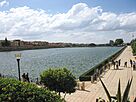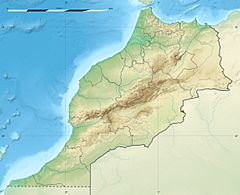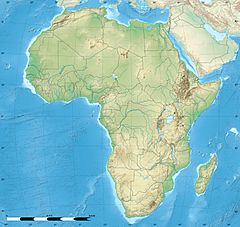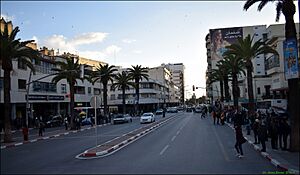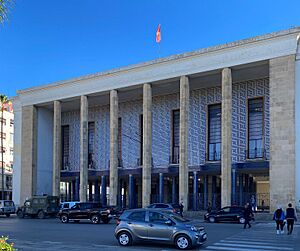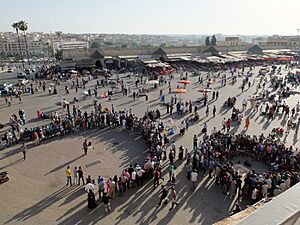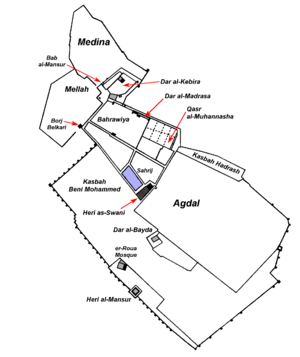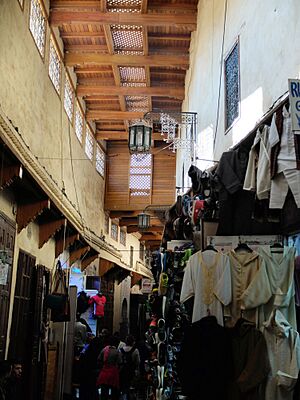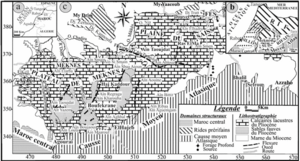Meknes facts for kids
Quick facts for kids
Meknes
مكناس
|
|||||||||||
|---|---|---|---|---|---|---|---|---|---|---|---|
|
Clockwise from top: Place el-Hedim and Bab Mansour, Sahrij es-Swani, Mausoleum of Moulay Ismail, Bou Inania Madrasa, Bab el-Khemis
|
|||||||||||
|
|||||||||||
| Country | |||||||||||
| Region | Fès-Meknès | ||||||||||
| Prefecture | Meknes | ||||||||||
| Area | |||||||||||
| • Total | 370 km2 (140 sq mi) | ||||||||||
| Elevation | 546 m (1,792 ft) | ||||||||||
| Population
(September 2014)
|
|||||||||||
| • Total | 632,079 | ||||||||||
| • Rank | 6th in Morocco | ||||||||||
| • Density | 1,708/km2 (4,420/sq mi) | ||||||||||
| • Municipality | 520,428 | ||||||||||
| Time zone | UTC+1 (CET) | ||||||||||
| • Summer (DST) | WEST (UTC+01:00) | ||||||||||
| Postal code |
50000
|
||||||||||
|
|||||||||||
Meknes (Arabic: مكناس, romanized: maknās) is one of the four Imperial cities of Morocco. It is located in northern central Morocco. It is the sixth largest city in the country by population.
Meknes was founded in the 11th century by the Almoravids. It started as a military camp. Later, it became the capital of Morocco. This happened during the rule of Sultan Ismail Ibn Sharif (1672–1727). He was a son of the founder of the Alaouite dynasty. Sultan Ismail built a huge imperial palace complex. He also added many strong walls and grand gates to the city. In 2014, the city had a population of 632,079 people. Meknes is an important economic center in the Fès-Meknès region.
Contents
Etymology
Meknes gets its name from an Amazigh (Berber) tribe. This tribe was known as the Miknasa. In Amazigh languages, their name is Imeknasen.
History
Early History (8th–16th centuries)
The ancient Roman city of Volubilis is close to where Meknes is today. However, Meknes itself started with a Berber tribe called the Miknasa. They settled in this area around the 10th century. They built small villages without walls.
In the 11th century, the Almoravids took over the area. They built a fort south of these villages. This fort was the beginning of what is now the old city of Meknes. The Nejjarine Mosque is thought to be the oldest mosque in Meknes. It dates back to the Almoravid period. The Grand Mosque of Meknes was also first built by the Almoravids in the 12th century.
Later, the Almohads destroyed the city after a long fight. But in the early 13th century, the Almohad ruler Muhammad al-Nasir rebuilt Meknes. He also rebuilt its walls and the Grand Mosque. The city did well during this time.
The Marinid dynasty took over in 1244. The first kasbah (a type of fortress) in Meknes was built by Sultan Abu Yusuf Yaqub ibn Abd al-Haqq in 1276. This was the same year the citadel of Fes Jdid was built in nearby Fes. Meknes was often a home for Marinid princes and important officials. The Lalla Aouda Mosque was also first built in 1276. The Marinids also fixed up the Grand Mosque. They built important schools called madrasas nearby. These included the Bou Inania Madrasa in 1336.
After these dynasties, Meknes was not as important. The new Saadian rulers focused on their capital, Marrakesh.
The Reign of Moulay Isma'il (17th–18th centuries)
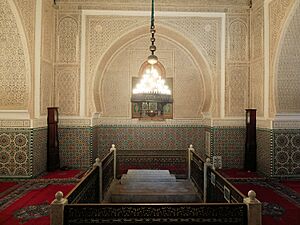
Meknes became important again in the late 17th century. This was under the Alaouite rulers. Moulay Rashid was the first Alaouite sultan to unite Morocco. His brother, Moulay Isma'il, governed Meknes. When Rashid died in 1672, Moulay Isma'il became sultan. He chose Meknes as his new capital.
Sultan Isma'il started building a huge new palace-city. It was on the south side of the old city. Construction began in 1672 and continued for 55 years. Old buildings were torn down to make space. The large public square in front of the Kasbah is called el-Hedim. This name means "the rubble" because of the debris piled there. Many workers, including some prisoners of war, helped build it. Stories about thousands of Christian slaves and large underground prisons are mostly exaggerated. The chambers often called "prisons" were actually big storage rooms for grain and supplies.
During Moulay Isma'il's rule, the Jewish people of Meknes moved to a new Jewish quarter called a Mellah. It was located near the Kasbah. Moulay Isma'il also rebuilt the city walls. He built new grand city gates like Bab Berda'in and Bab Khemis. He also built several forts around the city. These forts housed his special troops and helped protect the town. He also fixed up the Grand Mosque. One of his wives, Khnata bent Bakkar, was a powerful minister. She helped build the Bab Berda'in Mosque, finished in 1709.
One of his last projects was the Heri al-Mansur. This palace was built between 1721 and 1725. It was on the far south side of the kasbah and included huge stables. The famous gate, Bab al-Mansur al-'Alj, was finished in 1732 by his son Moulay Abdallah. Moulay Isma'il's son, Moulay Ahmad ad-Dhahabi, made changes to his father's tomb. He was also buried there in 1729.
Later Alaouite Period (18th–20th centuries)
After Moulay Isma'il died, there was a lot of fighting for power in Morocco. Meknes lost its status as capital. It was also damaged by an earthquake in 1755. Many parts of the huge imperial palace fell apart.
Sultan Mohammed ben Abdallah (1757–1790) built new things in Meknes. He added the Dar al-Bayda Palace. This palace later became a royal military academy. He also built the Er-Roua Mosque. This became the largest mosque in Meknes. He also fixed up the minarets of the Grand Mosque.
The Dar al-Kebira palace was left empty. People started building their homes within its old walls. In the early 19th century, Sultan Moulay Abd ar-Rahman added a special meeting place in front of Bab al-Mansur.
Recent History (20th–21st centuries)
When French colonial rule began in 1912, the French built a new city. This new city, called Ville Nouvelle, was on a plateau northeast of the old city. The capital of Morocco moved from Fes to Rabat. This made Meknes less important.
Meknes became a key transport center. It connected people and goods traveling across the country. It also had many military barracks. The population of Meknes grew a lot. It went from 25,000 people to over 140,000 by the mid-20th century. Most new buildings were in the Ville Nouvelle. The French also helped restore old monuments in the city. Meknes also became a center for farming and wine-making.
However, people in Meknes also resisted French rule. In 1937, there was a serious revolt. This happened when the French tried to use local river water for their own settlers. This caused food shortages for Moroccans. Protests turned violent, and many people died or were hurt.
After Morocco became independent in 1956, the city continued to change. More people moved from rural areas to the city. Industries grew around Meknes. But many old wealthy families moved to coastal cities like Casablanca and Rabat.
The old city was sometimes neglected. Today, there are efforts to fix and preserve its historic sites. This is partly because of tourism. Many major restoration projects are planned or are already happening. These include fixing city walls and old buildings like the Bou Inania Madrasa.
Geography
Meknes is located in a very important spot in the middle of Morocco.
- To its south and southeast are the Middle Atlas mountains. These mountains have rich cedar forests and cities like Ifrane and Azrou. Further south are the green areas of Tafilalet.
- To the west are Morocco's two biggest cities: Casablanca and Rabat.
- To the north are the mountains of northern Morocco. Here you find cities like Tangier and Tétouan.
- Oujda and Fes are to the east of Meknes.
Climate
Meknes has a hot-summer Mediterranean climate. This means it has hot, dry summers and cool, wet winters. The climate is similar to some inland cities in southern Portugal or Spain.
Temperatures change a lot between day and night. In summer (June–September), days are hot. In winter (December–January), high temperatures are around 15.5 °C (60 °F). Night temperatures average 5 °C (41 °F). Snow is very rare in Meknes.
| Climate data for Meknes (Bassatine Air Base) (1991–2020, extremes 1919–2020) | |||||||||||||
|---|---|---|---|---|---|---|---|---|---|---|---|---|---|
| Month | Jan | Feb | Mar | Apr | May | Jun | Jul | Aug | Sep | Oct | Nov | Dec | Year |
| Record high °C (°F) | 26.9 (80.4) |
30.7 (87.3) |
32.6 (90.7) |
36.4 (97.5) |
41.7 (107.1) |
43.9 (111.0) |
46.8 (116.2) |
46.2 (115.2) |
43.0 (109.4) |
37.7 (99.9) |
36.4 (97.5) |
27.1 (80.8) |
46.8 (116.2) |
| Mean daily maximum °C (°F) | 15.8 (60.4) |
17.0 (62.6) |
19.6 (67.3) |
21.7 (71.1) |
26.1 (79.0) |
30.4 (86.7) |
34.1 (93.4) |
34.1 (93.4) |
29.7 (85.5) |
25.7 (78.3) |
19.9 (67.8) |
16.9 (62.4) |
24.2 (75.6) |
| Daily mean °C (°F) | 10.4 (50.7) |
11.4 (52.5) |
13.8 (56.8) |
15.6 (60.1) |
19.3 (66.7) |
23.0 (73.4) |
26.2 (79.2) |
26.4 (79.5) |
23.0 (73.4) |
19.6 (67.3) |
14.6 (58.3) |
11.7 (53.1) |
17.9 (64.2) |
| Mean daily minimum °C (°F) | 5.0 (41.0) |
5.7 (42.3) |
7.8 (46.0) |
9.4 (48.9) |
12.4 (54.3) |
15.4 (59.7) |
18.2 (64.8) |
18.7 (65.7) |
16.2 (61.2) |
13.5 (56.3) |
9.2 (48.6) |
6.4 (43.5) |
11.5 (52.7) |
| Record low °C (°F) | −4.2 (24.4) |
−2.6 (27.3) |
−0.8 (30.6) |
0.5 (32.9) |
0.4 (32.7) |
5.2 (41.4) |
7.2 (45.0) |
9.0 (48.2) |
5.0 (41.0) |
2.2 (36.0) |
0.0 (32.0) |
−3.0 (26.6) |
−4.2 (24.4) |
| Average precipitation mm (inches) | 61.5 (2.42) |
55.2 (2.17) |
57.4 (2.26) |
45.7 (1.80) |
28.6 (1.13) |
8.5 (0.33) |
1.1 (0.04) |
3.3 (0.13) |
21.9 (0.86) |
49.2 (1.94) |
63.3 (2.49) |
65.6 (2.58) |
461.3 (18.16) |
| Average precipitation days (≥ 1.0 mm) | 6.9 | 6.6 | 6.9 | 6.1 | 4.0 | 1.0 | 0.3 | 0.7 | 2.4 | 5.2 | 6.3 | 7.0 | 53.4 |
| Average relative humidity (%) | 75 | 78 | 76 | 75 | 72 | 68 | 57 | 57 | 62 | 70 | 72 | 77 | 70 |
| Mean monthly sunshine hours | 174.3 | 176.2 | 226.6 | 236.9 | 283.4 | 305.5 | 347.8 | 328.4 | 264.4 | 227.7 | 176.5 | 165.8 | 2,913.5 |
| Source 1: NOAA (sun 1961–1990), (February record high) | |||||||||||||
| Source 2: Deutscher Wetterdienst (humidity 1973–1993 and extremes 1913–1993) | |||||||||||||
City Districts
Meknes is divided into many districts. Here are some of them:
|
|
|
|
Prefecture
Meknes is the main city of the Meknès Prefecture. This area includes 6 municipalities (like Meknes city) and 15 rural areas.
Historic Monuments and Landmarks
The most important historical buildings in Meknes are in the medina (old city). They are also in the huge former Kasbah of Moulay Ismail to the south. Here are some of the most famous ones.
Place el-Hedim
El-Hedim Square is a very large open space. It is at the southern end of the old city. It is right before the main gates of Moulay Isma'il's old royal palace. The name "el-Hedim" means "the rubble" or "the debris". This name comes from the materials piled up here when Moulay Isma'il built his palaces. He left this space open to separate his palace from the rest of the city. Today, the square is a lively place. You can see storytellers, acrobats, and musicians there in the evenings.
Mosques and Madrasas
- Grand Mosque of Meknes: This is the most important mosque in the old city. It is also one of the oldest. It covers about 3,500 square meters. It was first built in the 12th century. It has been repaired and changed many times since then.
- Madrasa Bou Inania: This is the city's most famous madrasa. A madrasa is a school for Islamic studies. It was built in 1335-36. It is known for its beautiful decorations. Today, visitors can explore this stunning building.
- Nejjarine Mosque: This mosque is often said to be the oldest in Meknes. It also dates back to the Almoravid period. It has been changed many times over the years.
- Lalla Aouda Mosque: This was the main mosque of the city's old fortress and Moulay Isma'il's palaces. It was first built in the Marinid era. But Moulay Isma'il completely rebuilt it between 1672 and 1678. Its tall minaret can be seen from the nearby Lalla Aouda Square.
- Bab Berda'in Mosque: This mosque is near the northern gate of the old city. It was finished in 1709. It was built on the orders of Khnata bent Bakkar, Morocco's first female minister. In 2010, its minaret fell, and 41 people died. The mosque has since been repaired and its minaret rebuilt.
- Ar-Roua Mosque: This is the largest mosque in Meknes. It was built by Sultan Mohammed ben Abdallah between 1757 and 1790. It is located in the southern part of Moulay Isma'il's Kasbah.
- Zitouna Mosque: A large mosque built by Sultan Moulay Isma'il around 1687.
- Zawiya of Sidi Mohammed Ben Aissa: This is also known as the Mausoleum of Sheikh al-Kamel. It is an important religious complex just outside the city walls. It was first built in the late 18th century. Mohamed ben 'Aissa, who founded a Sufi brotherhood, is buried here. He is seen as the patron saint of Meknes.
- Zawiya of Sidi Kaddour el-Alami: This is a beautifully decorated mosque and religious complex. It honors the tomb of Sidi Kaddour el-Alami. He was a famous Moroccan poet who died in 1850.
Fortifications and Gates
- Bab Mansur al-'Alj: This is the most famous gate in Meknes. It faces the southern end of Place el-Hedim. It was the grand entrance to the Kasbah of Moulay Isma'il. It was started during Moulay Isma'il's rule and finished in 1732 by his son. Its name comes from its designer, Mansour al-'Alj. He was a former Christian prisoner who became Muslim. The gate is known for its large size and rich decorations.
- Bab Jama' an-Nouar: Another fancy gate next to Bab Mansur.
- Bab ad-Dar al-Kebira: This is the grand entrance gate to the Dar al-Kebira palace. It dates back to 1679–80.
- Bab el-Khemis: A large western gate of the city. It is near the old Jewish quarter. It was built in 1687 during Moulay Isma'il's reign. It has rich decorations similar to Bab al-Mansur.
- Bab al-Barda'in: This is the large northern gate of the city. It was also built by Moulay Isma'il and is beautifully decorated.
- Borj Belkari: This is a tower built in the 17th century. It was part of the defensive walls of the Kasbah of Sultan Moulay Ismail. Since 2003, it has been a pottery museum.
Imperial Palaces of Moulay Isma'il
The palace complex of Sultan Moulay Isma'il was built over his entire 55-year rule (1672 to 1727). It is about four times larger than the old city itself. It had several separate palaces, huge gardens, religious buildings, and other facilities. The complex also had an amazing water system. This system used wells, water wheels, and underground pipes to bring water to all the royal buildings. It also had huge granaries and underground storage rooms. These could hold enough supplies to last the city for ten years. Here are some of its main areas and buildings.
- Place Lalla Aouda: A very large open square behind Bab al-Mansur. It was the main public space of the palace. It leads to the old Dar al-Kebira palace and the Lalla Aouda Mosque.
- Dar el-Kebira: This was the oldest palace in the kasbah. It was finished in 1679. It was the private home of the sultan and his family. After Moulay Isma'il died, the palace fell into ruin. Now, it is a neighborhood where people have built their homes among the remains of the old palace walls.
- Mausoleum of Moulay Isma'il: This is the royal tomb complex for Moulay Isma'il and some of his family. It was built during his reign. It was changed a lot by Ahmad ad-Dhahabi between 1727 and 1729. It is still a religious site today, but tourists can also visit. It has courtyards that lead to a beautifully decorated indoor area. This area then leads to the sultan's tomb.
- Qubbat al-Khayyatin and the Qara Storage Rooms: The Qubbat al-Khayyatin is a special room where Moulay Isma'il met with foreign visitors. Right next to it, underground, is a large vaulted space called the Qara Storage Rooms. Even though it is often called a "prison" for Christian slaves, experts agree it was actually a huge storage area for grain and supplies. It was one of many such storage buildings in the royal city.
- Dar al-Makhzen: This is a huge walled area. It was much larger and better organized than the Dar el-Kebira. It had large gardens and two more main palaces during Moulay Isma'il's time. Some parts are now used as a royal residence for the King of Morocco.
- Heri as-Swani and the Sahrij (Agdal Basin): The Sahrij, or Agdal Basin, is a huge artificial lake. It is south of the Dar al-Makhzen. It was part of the royal city's water system. It is 148.75 by 319 meters and about 1.2 meters deep. Next to it is a huge building with two parts. One part is called the "House of the Ten Norias" or Dar al-Ma. It had water wheels that brought water from underground to the surface. This water then went into the Sahrij or to other parts of the city. The second part is the Heri as-Swani. It has 22 rows of huge arches that once held up a vaulted roof. This roof has now fallen down. People often mistakenly call this the "royal stables". But it was actually a massive granary and storehouse for grain.
- Heri al-Mansur: This was one of the last buildings Moulay Isma'il built (1721–1725). Its name means "Granary of Victory". It was a huge building that served as a palace, fortress, and storehouse. The basement was for storage. The upper floor had reception rooms with views of the area. Next to it were Moulay Isma'il's Royal Stables. These stables were very impressive. They had horse stalls under two long rows of arches, stretching for 1200 meters. A water canal ran between them for the horses. Sadly, these stables are not preserved today.
-
The Mausoleum complex of Moulay Isma'il
Synagogues
- The Rabbi Meir Toledano Synagogue is still in Meknes. People believe it was first built in the 13th century. The Toledano family rebuilt it in 1646.
- The Etz Hayeem synagogue in Meknes is also a historic synagogue.
Museums
- Dar Jamaï Museum: This is the most famous museum in Meknes. It has many old objects and art from Meknes and other parts of Morocco. It is located in a beautiful palace built in 1882.
- Musée de Meknès (Meknes Museum): A small museum near Bab al-Mansur. It shows items from all over Morocco.
Outlying Sites
The ruins of the ancient Roman town of Volubilis are about 30 minutes north. Volubilis is also a UNESCO World Heritage Site. The village and important religious site of Moulay Idriss Zerhoun is also nearby.
Economy
Meknes is an important economic center in Morocco. It has many products from farming, industry, and services. This makes the city good for business and investment.
Competitiveness
A report from the World Bank in December 2015 said that Meknes is one of the three most competitive cities in Africa. Two of these three cities are Moroccan: Meknes and Tangier.
Agriculture
Meknes is known as the capital of agriculture in Morocco. The Saïss plain, where Meknes is located, is one of the most fertile and rich plains in Morocco.
Every April since 2006, Meknes hosts the International Agriculture Show in Morocco. This show is very large, covering over 250,000 square meters. More than 60 countries and over 1,200 exhibitors take part.
The lands around Meknes are very good for growing things. The high elevation, rich soil, and fresh water help grow many fruits and vegetables. These include peaches, nectarines, plums, apples, potatoes, onions, and garlic. Meknes is also famous for its olives and olive oil. Raising animals like sheep and cattle is also common. Meknes has big factories for milk and dairy products. These factories provide most of what the region needs.
Industry
The industry in Meknes is mostly light manufacturing. A lot of it is related to food processing. There are also chemical industries in other areas. Textile and metal manufacturing are older industries in the city. Since 2016, new industries have started in Meknes. These include companies that make electrical wires, computer systems, and car parts.
Major Companies
| Name | Year |
|---|---|
| Yazaki | March 2016 |
| Delphi Automotive | 2016 |
| Lafarge Holcim | |
| Salidor | 1993 |
| Yura Corporation | 2016 |
Services
Many services in Meknes are related to tourism. This is because of the many attractions in the old city district (the medina).
Transport
Road
Meknes is in a key location in Morocco. This makes it an important transport hub. You can reach the city using the A2 expressway. There are two exits, one to the east and one to the west of the city.
The city's main bus station (Gare Routière) is west of the medina. This is also where you find the main station for grand taxis (taxis for travel between cities). A newer bus station for CTM buses is near the main train station.
Rail
There are two train stations in the new city district of Meknes. Trains run every hour to the east, west, and north of Morocco. The trains are operated by ONCF.
| Direction | Route | Frequency | ||
|---|---|---|---|---|
| West | Fez - Meknes - Kenitra - Rabat - Casa Voyageurs | Every 2 hours | ||
| West and South West | Fez - Meknes - Sidi Kacem - Sidi Slimane - Kenitra - Salé - Rabat - Mohammedia - Casa Ain-Sebaa - Casa Voyageurs - Casa Oasis - Berrechid - Settat - Ben Guerir - Marrakesh | Every 2 hours | ||
| North | Fez - Meknes - Sidi Kacem - Ksar el-Kebir - Tangier - Ksar es-Seghir | 6 trains a day | ||
| East | Casa Voyageurs - Casa Ain-Sebaa - Mohammedia - Rabat - Salé - Kenitra - Sidi Slimane - Sidi Kacem - Meknes - Fez - Taza - Guercif - Taourirt - Oujda | Two trains a day | ||
| West | Meknes - Sidi Kacem - Sidi Slimane - Kenitra - Salé - Rabat - Mohammedia - Casa Ain-Sebaa - Casa Port | 3 trains every Sunday PM | ||
Meknes has two train stations: Meknes Railway Station and Meknes Amir Abdul Qadir Railway Station. All trains stop at the first station. Most trains also stop at the second station.
Air
The closest airport is Fes-Saïss Airport. You can only reach it by road. Another option is Mohammed V Airport in Casablanca. It has more international flights. You can easily reach it by train from Meknes. There is also a military airport in Meknes.
Public Transport
The city manages public transport in Meknes. It includes:
- A large network of buses that cover the entire prefecture. Some lines even go outside the prefecture, like to El Hajeb.
- Taxis in the city come in two types. Small taxis can hold up to 3 people and use a meter for fares. Bigger taxis can hold up to 6 people. They have set routes and fixed prices.
Education
Meknes is home to the public Moulay Ismail University. This university has several faculties, schools, and institutions. They are located on three campuses in Meknes, Errachidia, and Khenifra.
In Meknes, you can find:
- Faculty of Sciences (FS), started in 1982
- Faculty of Letters and Human Sciences (FLSH), started in 1982
- Normal Superior School (ENS), started in 1983
- Faculty of Juridical, Economical and Social Sciences (FSJES), started in 1993
- Superior School of Technology (EST), started in 1993
- National Superior School of the Arts and Professions (ENSAM), started in 1997
In Errachidia:
- Faculty of Science and Technology (FST), started in 1994
- Poly disciplinary Faculty (FP), started in 2006
In Khenifra:
- Superior School of Technology (EST), started in 2014
Besides Moulay Ismail University, Meknes also has many private schools for higher education.
International Relations
Meknes is twinned with several cities around the world. This means they have a special friendship and cooperation.
Notable People
Here are some famous people who are from Meknes:
- Abdeljalil Hadda, a former international Moroccan football player
- Aryeh Deri, an Israeli politician
- Aziza Jalal, an Arabic Pop singer
- Driss Roukhe, a Moroccan actor
- Faouzi Bensaïdi, a Moroccan actor and film director
- Khalid Ismail, a Moroccan MMA fighter
- H-Kayne, a rap group based in Meknes
- Houcine Toulali - a Moroccan Malhun singer and writer
- Karima Abd-Daif, a Norwegian politician
- Laïla Abid, a Dutch journalist
- Latefa Ahrar, a Moroccan actress
- Malika Akkaoui, a Moroccan athlete
- Kaddour El Alamy, a Moroccan poet
- Chuck Martini (born Choukri Moussaddik), a former Moroccan football player
- Muhammad Al Barka, a writer and historian
See also
 In Spanish: Mequinez para niños
In Spanish: Mequinez para niños




